Marking of circuit breakers: how to choose the right circuit breaker for wiring
Circuit breakers installed in apartment electrical panels are designed for emergency power outages in the event of a short circuit or excess load on the circuit. They can also be controlled manually when it is necessary to change the switch.
The markings of the circuit breakers, presented in the form of names, alphanumeric designations and diagrams, will tell you what parameters the device has. Agree, the ability to “read” the inscription will be useful to the home handyman if he needs to replace a device, fix breakdowns, or connect an additional machine.
We will help you figure out what's what. The article describes a detailed explanation of the marking block on the switches, and also provides recommendations for choosing a machine, taking into account its characteristics.
The content of the article:
Why is labeling necessary?
For a qualified electrician, the front panel of the machine is like an open book - in a couple of minutes he can find out everything about the device, from the manufacturer to the rated current value. An experienced installer can easily distinguish between devices that are absolutely identical from the point of view of the average person.
A homeowner unfamiliar with the intricacies of electrical wiring can also understand the information provided by the manufacturer.
Using special symbols located on the front panel, you can distinguish an automatic machine from an RCD, find out its main technical characteristics and find out in what sequence the wires are connected.
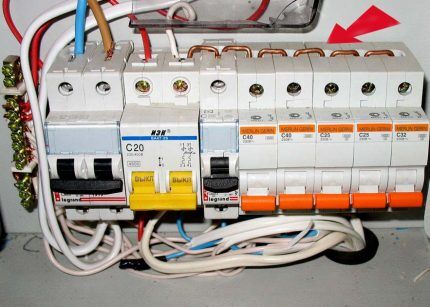
Information about a separate circuit breaker may be required if:
- it is necessary to replace the device;
- should pick up a new machine due to the appearance of an additional circuit;
- it is required to compare the rated current load of the line and the circuit breaker;
- you need to find the cause of the emergency shutdown, etc.
Some symbols become intuitive, while others require certain knowledge to decipher. If you are planning to replace the wiring yourself or connect the circuit breaker, it is better to study information about devices in advance.
What do the inscriptions on the switch mean?
Symbols, numbers, letters, diagrams are applied to technical plastic with special indelible paint. Even with older models they remain readable. It is assumed that the user or electrician, barely glancing at the machine, should quickly determine its current characteristics and voltage.
Manufacturer and model of the machine
The top line of the marking block is occupied by the brand name. A certain color is selected for printing, often bright, and sometimes even by the shade you can determine which manufacturer’s products are in front of you.
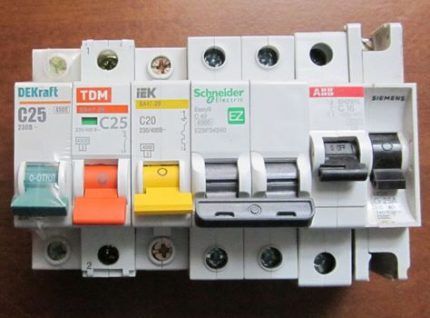
Experienced electricians suggest not to skimp when buying machines and to purchase devices only from proven European brands: Schrack Technik, Schneider Electric, ABB, Schaltbau, Moeller, HAGER, Legrand. There are several Russian brands that you can also safely trust: Electrician, TDM ELECTRIC, EKF.
The line below indicates the device model. All other inscriptions, except for the manufacturer's name, are usually printed in gray, so the series can be easily confused with technical specifications.
In order not to be mistaken, we look exactly at the second line. The line or model designation may look like this: VA63, SH200, Acti9.
You can try to decipher the series, but the technical characteristics are not always hidden behind the letters and numbers; more often it is just the name of a specific model.
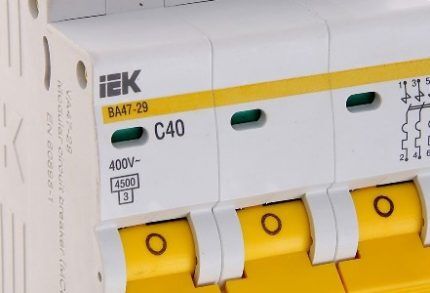
The line designation can be printed either on a general gray background or on a colored line, which is located directly under the brand.
Determination of time-current characteristic
The next line is a combination of a Latin letter and a number. The first letter indicates the time-current characteristic. It refers to how quickly a switch operates when a certain amount of current flows through it. There are five different types in total: “B”, “C”, “D”, “K”, “Z”, but in everyday life machines B, C, D are used.
The dependence of quantities is often presented in the form of graphs that can be found on the Internet. They look like this:
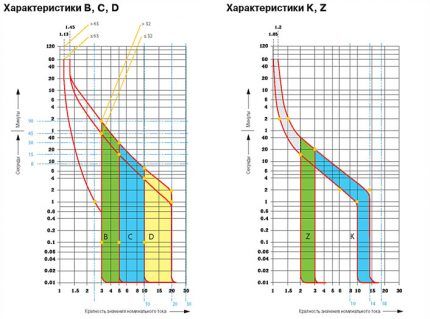
Thus, if the value of k is between 3 and 5 - this is category B, between 5 and 10 - C, between 10 and 20 - D.
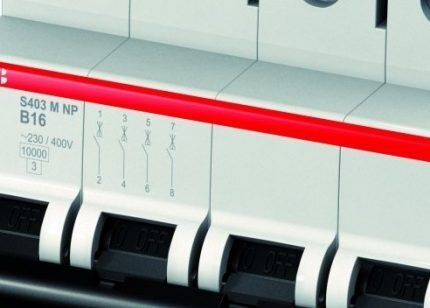
If you take two switches with the same rated current value, but with different tripping properties, they will also react differently. For comparison, consider C16 and B16. If we use the formula, then as a result we will get for C16 - 80-160 A, and for B16 - 46-80 A.
What does this look like in practice? Suppose the current sharply increases to 100 A. B16 will turn off instantly, since 80 A is enough for it, and for C16 to work, it takes some time for the plate to heat up. Then the thermal protection begins to operate and the machine turns off. The time difference usually takes a fraction of a second.
Rated current and its designation
The number to the right of the Latin letter (BTX) indicates machine denomination. The rated current indicates at what maximum value the machine will be in the operating state, that is, the current will freely pass through it without emergency shutdown.
An important point: the specified data is relevant only at a certain temperature, namely +30ºС. If the temperature is higher, the switch may operate at a lower current value.
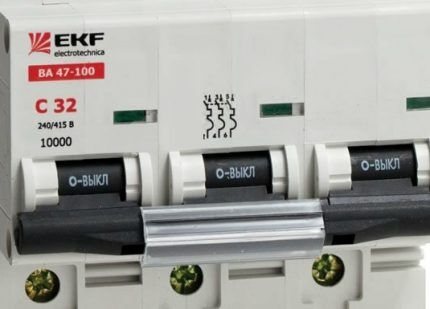
Let's look at what happens inside the device during a trigger. The machine is turned off thanks to the operation of two types of circuit releases - thermal and magnetic.
The first one comes into operation if there is an overload in the electrical network. A current value higher than the rated one heats up the bimetallic plate, it bends and breaks the circuit - the machine turns off. It is estimated that the load current must exceed the nominal by 15-55% for a break to occur.
But in addition to overload in the network, there is also such a phenomenon as overcurrent. The reason for its appearance is a short circuit. It is no longer the thermal, but the electromagnetic release that reacts to overcurrents.
If the device is in working condition, the response occurs instantly, within a maximum of 0.02 seconds. A delay in emergency shutdown leads to failure of the wires. First, the insulating layer melts, then a fire may occur.
To protect wiring and your own life from overloads and short circuits, it is recommended to purchase only high-quality protection devices.
Rated voltage and frequency markings
The line below indicates the value of the rated voltage. It must also be observed when choosing a device without fail. Marking can be determined by units of measurement - Volts, which are designated by the letters V or V. For accuracy, the following symbols are also used: “-” - constant voltage, “~” - alternating.
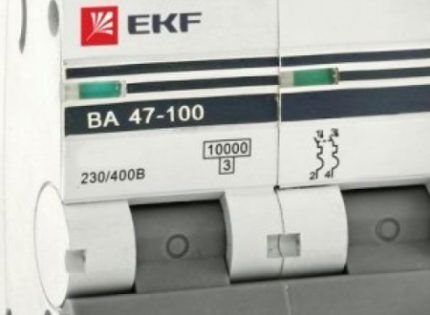
The frequency is determined in Hertz and is designated as 50 Hz.But it may not be detected on the case, because almost all household appliances operate in the same mode.
If you need to know exactly some characteristics of the machine, but their designations are not on the panel, you should look at the instructions, which list all the technical data about the device.
Trip current limit
The next value indicated on the body of the machine is the shutdown current, which is otherwise called the breaking capacity of the device.
If a short circuit suddenly occurs and an overcurrent appears in the circuit, the machine will operate in emergency mode, but at the same time fully retain its functionality. You can see that the shutdown current is several times higher than the nominal value.
It is also possible that the overcurrent value will be higher than that indicated on the machine. Then there is no guarantee that the device will work correctly and will not be damaged. Most likely, the magnetic release simply cannot cope with the load.
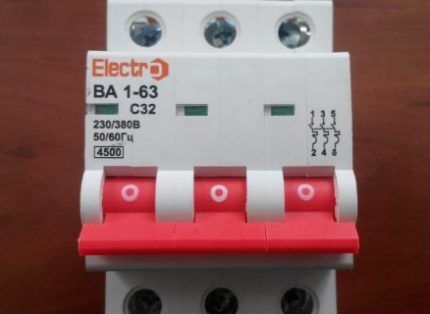
In addition to the value of 4500 A, which is typical for many household-class machines, you can find 6000 A and 10000 A.
What is current limiting class
Immediately below the tripping current limit is the current limiting class. It is easy to find on the panel - it is the number 1,2 or 3, enclosed in a black square. During a short circuit and overcurrent appears in the network, the system may suffer.
The faster the machine operates, the sooner the effect of thermal energy, which is a consequence of the occurrence of overcurrent, will cease, and the sooner stability will occur.
Thus, the current limiting class shows the time interval to which the machine can limit the short circuit time.
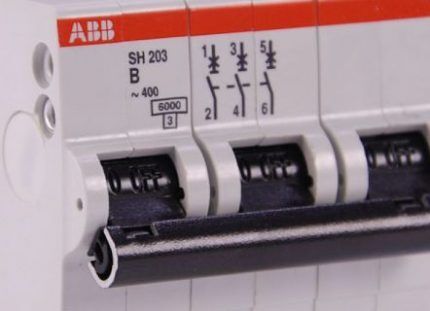
Class divisions:
- 1 class – limit > 10 ms;
- 2nd grade – from 6 to 10 ms;
- 3rd grade – from 2.5 to 6 ms.
The third class is the “fastest” and preferable when choosing an automatic machine.
Wiring diagram
On some circuit breakers, in addition to the main characteristics, you can find a connection diagram. It is usually located on the right side of the front panel.

The circuits on 1-pole and 2-pole devices are different. On the second, in addition to the circuit with contacts, there are terminal markings, and also on some models the N icon, indicating the connection of the neutral wire.
Tips for choosing a circuit breaker
The machine is selected based on certain characteristics, many of which can be recognized by the markings on the front panel.

In addition to the analyzed characteristics, you should know other nuances of choice. For example, before purchasing a machine, be sure to calculate its power and select the required number of poles.
More details about the calculation and selection of a circuit breaker are written in this article.
The brand is important, as is the condition of the wiring.
It is recommended to make a purchase in a specialized store. But recently, the practice of purchasing technical devices on commercial Internet sites, many of which are located in China, has become widespread.
When choosing, pay attention to the integrity and strength of the case. The slightest chip or crack can cause a breakdown, and mechanical damage is a sign of poor quality material.
Conclusions and useful video on the topic
General information about the machines is disclosed above, and from interesting videos you can learn about the intricacies known only to professionals.
How the machine works and works:
More details about thermal ratings - analysis of the table:
We read the label with a specialist:
The markings printed directly on the device body help you choose and connect the home power supply protection device correctly.The ability to decipher symbols and correctly determine characteristics will help in the future when independently installing a new circuit.
Do you have anything to add, or do you have questions about deciphering the markings of circuit breakers? You can leave comments on the publication and participate in discussions. The contact form is located in the lower block.



